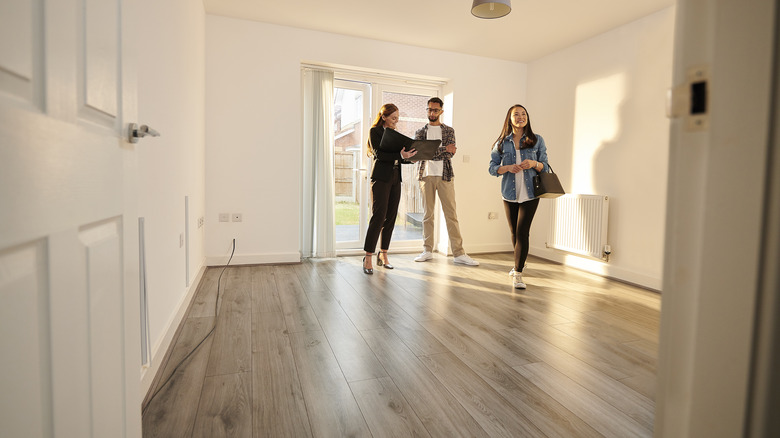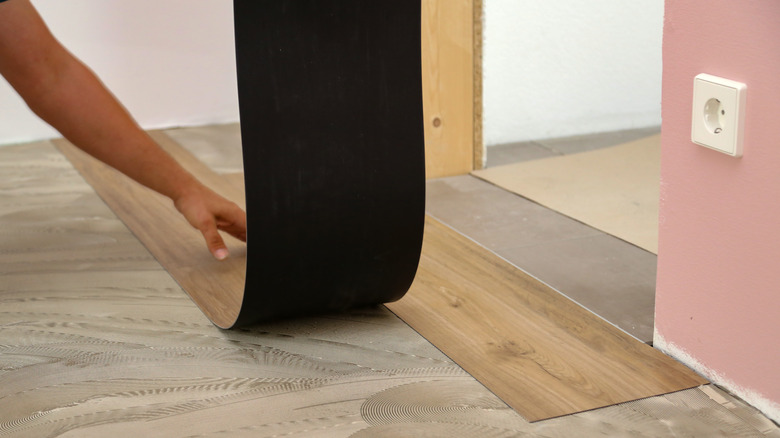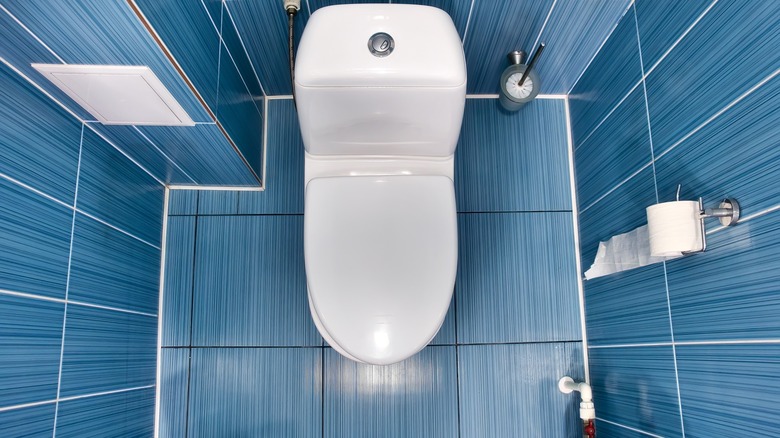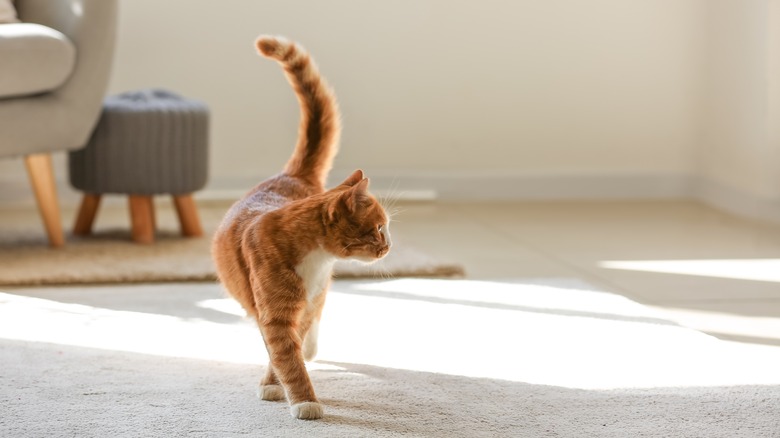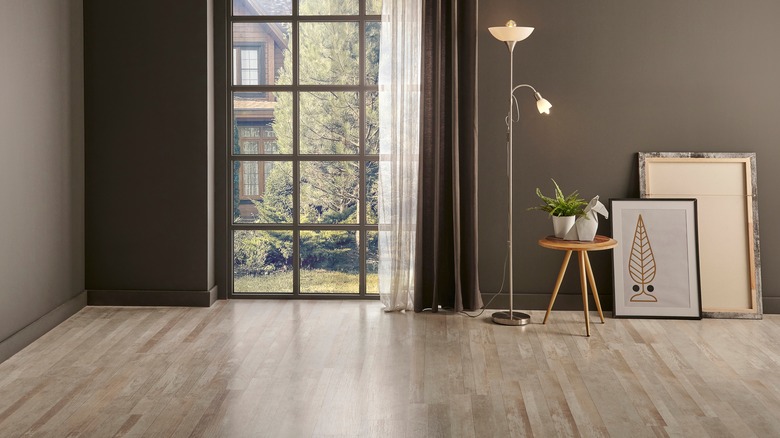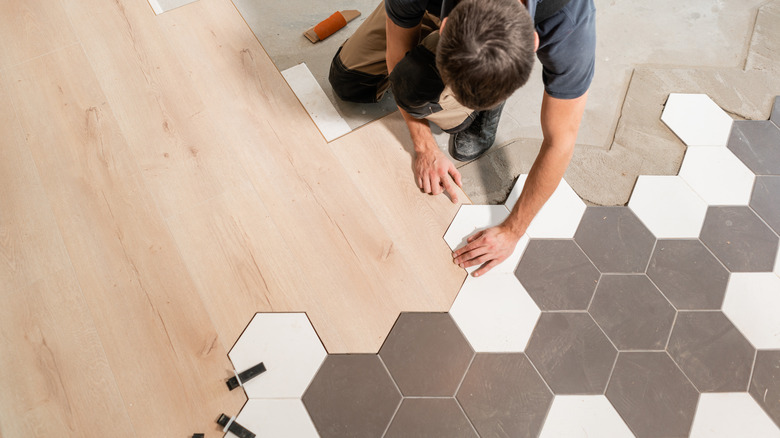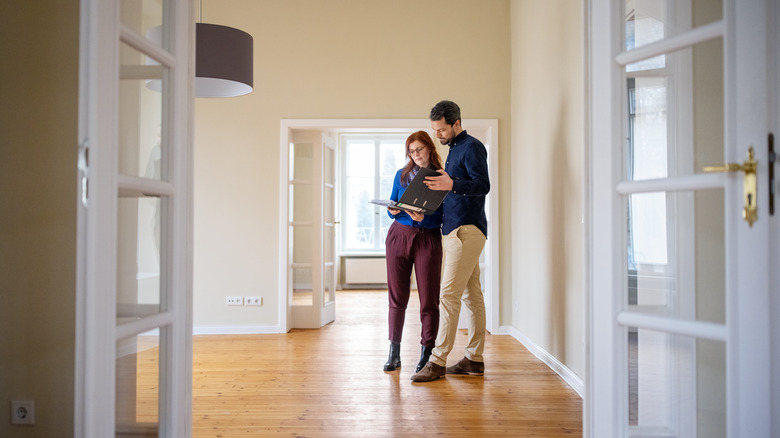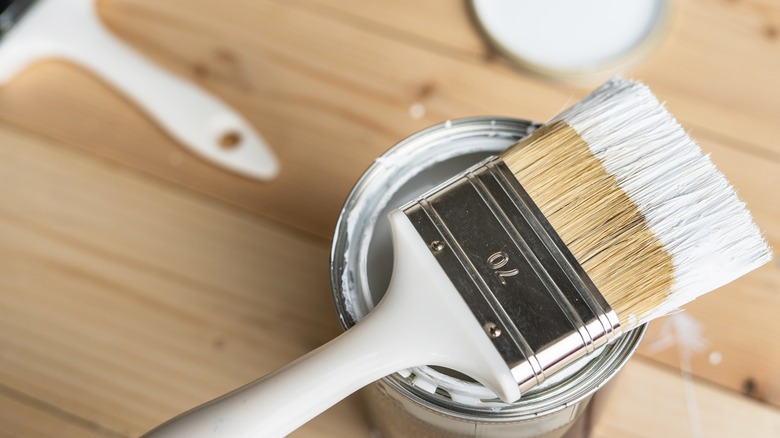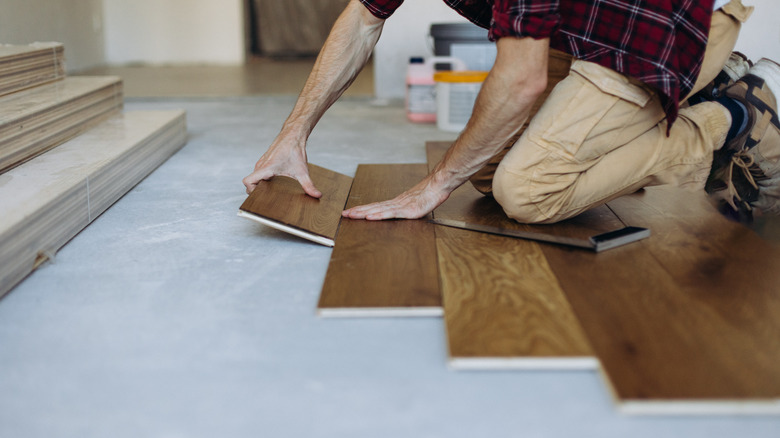Flooring Choices That Will Make It Harder To Sell Your Home
According to research carried out by Ipsos for Zillow, 75% of Americans agree that successfully selling a house is a stressful event. Around 60% say it's more stressful than getting fired or planning a wedding. Given these findings, there's no reason to make selling your home any harder than it has to be. If you want to reel in buyers like salmon in September, upgrading your floors could be the ticket. Floors are one of the first things buyers see, and they're also the most disruptive to upgrade. RE/MAX executive Adrian Goslett told Property24, "Excessive wear and tear on the flooring will drive buyers away. Focusing on getting your flooring looking its best before listing the house is an important step towards selling for full value." But simply installing a new finish underfoot isn't sure to net you a better sale price. Nor is it guaranteed to trigger a faster close. In fact, certain flooring choices can actually derail a successful sale.
Obviously, cheap choices can be a turn-off. DIY upgrades can often look better on paper (or Pinterest) than they do during showings. On the other end of the scale, overly expensive flooring can also be an issue. Even hardwood, the darling of floor finishes, can have certain drawbacks when it comes to resale. Installing a new floor isn't a small undertaking, so it's worth thinking carefully before you make any changes. Let this guide walk you through some of the worst flooring choices for resale and the reasons why buyers dislike them so much.
Low-quality laminate and vinyl won't win buyers' hearts
Grabbing a great deal on some super budget-friendly flooring might feel like a win, but it could cheapen your home and chase away buyers. During an exclusive interview with House Digest, Shaun Martin, founder of Sell My Home Fast, shared that low-quality vinyl and laminate flooring can tank resale value, especially if installed in high-traffic areas like the kitchen. The real estate veteran said, "These options are often seen as low-quality and can easily get damaged and worn out. They don't have the durability and longevity that other flooring types like hardwood or tile provide." Research from Zillow backs this up, showing that laminate flooring can cause properties to close at 0.6% less than comparable listings. This might not sound like much, but if your home is worth $500 thousand (just over the national average), you'd be $3,000 down. However, the average cost to install new flooring lies between $1,500 and nearly $5,000. If you pick a slightly pricier, more durable floor finish, you'll probably be able to recoup the extra cost and attract the interest of more buyers.
Price is a fair indicator of quality when it comes to laminate and vinyl flooring, but here are a few other factors to consider. First up, pattern. Is the pattern on the product you're choosing realistic, or is it pixelated and obviously printed? Thickness is another thing to consider, especially if you're installing luxury vinyl planks (LVP) or laminate planks. The thinner the boards, the less stable the flooring can feel underfoot. This is something buyers will be able to feel the moment they walk in the door, so opt for planks that are at least 4mm to 6mm thick for high-traffic areas. You'll also want to look at the wear layer thickness, especially if you're going to be living with the floors for a while before listing your home.
The wrong tile choice can be a turnoff
Tiles are a top choice if you're looking for longevity, which should make them ideal for resale. However, tiles do have a couple of drawbacks that can deter potential buyers. Amy Cook, a Realtor in San Diego, told Realtor.com, "Tile is very difficult and expensive to change, and often what owners choose just isn't very attractive. Basic white, dated tile is usually a big turn-off for buyers." Apart from aesthetics, tile can also be cold underfoot and very hard. If your buyers are elderly or have small children, they may view tile floors as a safety hazard.
Of course, tile can be the most practical choice for high-traffic areas and zones that see a lot of moisture, such as bathrooms or entryways. If you're putting in new tile with an eye to resell, pay close attention to the design and hue you choose. Now is probably not the time to make a bold, highly personal statement with color or pattern. You also want to avoid jumping on a tile trend that's already on the way out, such as gray tones. Although gray is a timeless color, all-gray interiors are becoming synonymous with the 2010s. Instead, warmer tones are taking over tiles, walls, and furnishings.
Do you already have neutral tile floors and are wary of ripping them out? If you feel like the actual tiles are still in good shape and aren't going to send buyers running for the hills, consider giving the grout a facelift instead. De-staining or re-grouting in a different color can give your tiles a fresh, updated look for a whole lot less.
Buyers don't care for carpet, especially in main living areas
Unless you've been living under a design rock, you're probably aware that wall-to-wall carpet isn't as popular as it used to be. When interviewed by Homelight, Dallas real estate agent Ashlynn Petrocco revealed that when it comes to living areas, sellers should opt for "wood flooring or even laminate, and anything hard surface over carpet." One of the reasons why wall-to-wall carpet doesn't bewitch buyers is reduced wearability. A single red wine spill or a splash of spaghetti sauce can cause a new pile to lose its perfection. Old, worn carpeting is an even bigger issue. Nobody wants to buy a house that has dead skin cells, pet dander, and decades of dust hiding in the carpet loom. Besides being harder to keep pristine, wall-to-wall carpet can also harbor allergens, dust mites, and more.
But this doesn't mean buyers are opposed to carpet across the board. Its insulating, cozy, and noise-dampening qualities make carpeting a common choice for bedrooms, playrooms, and even basements. According to Petrocco, "A lot of people still use carpet on the second floor instead of the first. It can help reduce noise, especially when there are young children, it's more comfortable in areas where you may be spending more time on the ground, and it keeps the floors warmer."
The takeaway? Feel free to keep carpeting in low-traffic areas, provided it's in great shape. For living spaces, entrances, and high-traffic zones, consider replacing it with an option buyers won't have any qualms with, such as luxury vinyl planks. But before you head to the hardware store, pull up a corner of the carpet. If there's hardwood underneath, you might be able to restore it. Provided there isn't any damage, refinishing hardwood flooring can be a cost-effective option.
Dated wood tones don't impress
Hardwood and its faux friends, laminate and luxury vinyl planks, are by far some of the most popular flooring options with buyers. But watch out before you hit "go" on your reno, because the wrong wood tone could seriously time stamp your home and send buyers in search of the next listing. Gray-wash wood has been having a huge moment, but the trend tide has turned on this wood tone. According to designer Kylie M., a leading color consultant, "The gray trend started about eight to 10 years ago, and while it's had a GREAT run, its time is up. These days, instead of gray-wash floors, my clients are leaning into more natural woods in light to medium depths." Ashy wood floors aren't a decorating sin, but they will date your space. Two other tones to steer clear of are very yellow and orange finishes.
While there's nothing inherently wrong with these warm woods, they can also have an inherently dated feel. Warm, yellow oak used to be everywhere during the '80s, and many people still associate it with this period. Another reason is that pine naturally turns yellow over time, as do a lot of lacquers and coatings. As a result, yellow-toned woods tend to give off a less-than-fresh aura. If you've got engineered or solid hardwood flooring that's turned yellow over time, you could opt to refinish it.
Mix n' match flooring isn't a luxe look
One of the trickiest decisions to navigate when redoing flooring is how far to go. Do you just replace the worn-out, high-traffic areas, or do you go the whole hog and rip everything out? Replacing the floors throughout your home could end up costing over $10,000 if you go with high-end materials, which might make you want to take on the project in chunks. But redoing floors piecemeal can give your reno a roughshod look.
There are areas where having two different types of flooring meet might be inevitable, such as hardwood and tile at the entrance to a bathroom. But the more harmonious you can make your flooring finishes, the better. Running the same material right through your home can give the feeling of a new build, visually open up the space, and create continuity. It's also simpler for homeowners than trying to match different floor finishes without the help of a design service. Want a wood look? Nowadays, there are lots of waterproof vinyl plank options, which means you can extend LVP flooring from living spaces into bathrooms and mud rooms. If you do need to combine multiple flooring finishes, try to limit the range of materials. For instance, tiles in the bathrooms and LVP throughout the rest of the house can still feel very cohesive and intentional. But a mixture of tiles, hardwood, wall-to-wall carpeting, and laminate? Not so much.
Hardwood could be a hard pass for homebuyers looking to let
If you've been doing some research, then you'll probably know that hardwood is bound to be a hit with most buyers. According to data from the National Association of Home Builders (NAHB), 32% of buyers named hardwood flooring in main living areas as a must-have, and 49% listed it as a nice-to-have. But there's one subset of home hunters that might not be as enamored with hardwood, and that is the buy-to-let crowd. A savvy landlord will likely be looking for long-lasting finishes that can handle abuse. During an exclusive interview, Schannon Yodice told House Digest that hardwood can be the worst flooring material to use in a rental home. "Hardwood floors are susceptible to scratches, dents, and water damage due to its softer and more porous nature. Having to refinish the hardwood flooring between tenants can become costly and time-consuming, which can impact the property's availability and your return on your investment. It is also on the more expensive side to purchase and install."
Investment and secondary home buyers make up only 4% of the market, according to NAR Realtor. However, 88% of house hunters see their future home as an investment. If you know that the property market in your area is brimming with investment buyers and families with small children and pets, it may be worth skipping the expense of installing hardwood. Instead, luxury vinyl planks can closely mimic the look of real wood while being cheaper, easier to install, lower maintenance, and more moisture-resistant.
Marble may chase maintenance-minded buyers away
Who wouldn't want a home lined with luxe, genuine marble floors? Well, quite a lot of people, as it turns out! According to the 2023 U.S. Houzz Bathroom Trends Study, only 11% of renovators shoot for marble floors in the bathroom. Marble's price point is one reason, as marble tiles can cost between $2 to $10 more than ceramic per square foot. The other is its porosity and susceptibility to discoloration. In an interview with Realtor.com, remodeling expert Alex Biyevetskiy said, "Marble offers unsurpassed sophistication, but its reputation for needing maintenance and for staining puts off a portion of potential buyers."
Most marble surfaces need to be resealed at least once a year. Sealing marble isn't very complicated, but you do need to thoroughly clean the surface, tape off any areas you don't want to get sealant on, apply it, let it dry, wipe away excess ... you get the picture. Busy homeowners and growing families might not have the time for this –- or the mental fortitude to accept that the marble floors will mar over time, even with regular sealing.
If you feel like natural stone would suit your home, you can always go with high-quality porcelain or ceramic tiles in a marble pattern. Tile manufacturing advances like inkjet printing are making highly realistic patterns possible, allowing homeowners and designers to get the marble look minus the maintenance.
Expensive flooring could price your home out of the market
Speaking of marble floors, installing very up-market finishes could make your home less sellable. Depending on the neighborhood and the overall price point of the property, you may not be able to recoup the cost of installing fancy features. Trying to work them into the asking price could mean your property becomes too expensive for potential buyers. Melissa Yocum, a real estate agent in Ohio, told Realtor.com, "I always look at the comps in the area and try to guide my sellers from there. It doesn't do any good to put marble in a $120,000 house because you're going to drive it past your price point. A nice laminate is going to go a long way in a low- or mid-range house."
An easy way to ensure you don't overspend on flooring is to use your home value as a guide. According to data from the NAHB, flooring accounts for 3.3% of construction costs in a new build, with an average cost of $13,019. Therefore, if your home is worth $500,000, you probably shouldn't be spending more than $13,000. If you want to get granular with this calculation, simply take your home value, subtract the land value (you may be able to use empty plots in the area as a guide), and then multiply by 3.3% (or 0.033).
Painting floors could push down your home's value
Getting hands-on with home improvements can help you achieve a better ROI, but there are some DIYs that are best avoided if you want to maximize resale value. One of these is poorly painted floors. Real estate investor and broker Patrick O'Sullivan told Realtor.com, "Streaky, chipped, or low-quality paint can make your home look cheap. Moreover, trendy patterns can distract the eye and feel noisy to some people. Too much personalization, like a customized painted floor, can hurt your home's resale value." So if you're tempted to jazz up old floors with a painted checkerboard pattern or a unique stencil, maybe don't.
There are times and places where painting a floor can offer a quick, cost-effective fix, but in most cases, paint is more of a cosmetic bandage than a long-lasting solution. Properly executed projects that involve the right prep, primer, and high-quality paint can withstand light traffic for up to a couple of years. But after this, you (or the new owners) will probably need to carry out periodic touchups. Most buyers don't want to have to maintain previous owners' DIYs, and many might not have the know-how. If you do decide to paint, make sure you shell out for a hard-wearing floor coating, such as professional-grade epoxy or polyurethane paint.
DIYed flooring isn't a look buyers love
Going gung-ho with floor paint and stencils isn't the only DIY project you may want to reconsider. If you have the experience and general handiness to install your own flooring, you could save on some serious labor costs. But if you've never set a tile, laid lino, or installed tongue and groove planks, it might be best to call in the pros. Sprucing up a home to sell is not the time for hands-on learning (and all the associated mishaps). Property expert Thomas Goodman told Love Property, "Professional work is second to none in quality. When buyers step into your home and agents do a valuation, they will take note of details. Your DIY tiling job might look appealing to you, but amateur work doesn't have the same finish."
This doesn't mean that you should never attempt a DIY improvement, but it's important to weigh your skill level before you tackle a task like tiling and potentially dent your resale value. If you don't honestly feel up to the job, there might still be ways you can save on labor by taking on aspects of the project that require less expertise. For instance, if you're replacing some shabby wall-to-wall shag with hardwood, ripping out and disposing of the carpet yourself can help you cut costs. Prepping the subfloor is another task you might be able to take on. Even opting to remove the furniture yourself instead of having a contractor clear the area may reduce your total bill.
